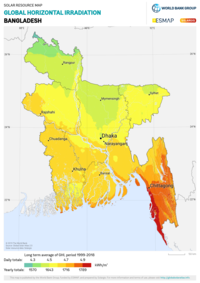Renewable energy in Bangladesh
 Teesta Solar Limited, the country's largest solar power plant |
Renewable energy in Bangladesh refers to the use of

Solar power

The long term average sunshine data indicates that the period of bright sunshine hours in the coastal regions of Bangladesh varies from 3 to 11 hours daily.
With an estimated 40% of the population in Bangladesh having no access to electricity, the government introduced a scheme known as solar home systems (SHS) to provide electricity to households with no grid access.[6] The program reached 3 million households as of late 2014 and, with more than 50,000 systems being added per month since 2009, the World Bank has called it "the fastest growing solar home system program in the world."[7]
The Bangladeshi government is working towards universal electricity access by 2021 with the SHS program projected to cover 6 million households by 2017.[8]
Clean energy accessibility extended to the 8.2 million inhabitants residing in rural regions of Bangladesh, ensuring universal electricity access across all households.[9]
Wind power
The long term wind flow, especially in the islands and the southern coastal belt of Bangladesh indicate that the average
Tidal power
The tides at
Waste to electric energy
In order to save the large cities from environmental pollution, the
Biogas
There mainly two types of
Geothermal energy
Geothermal potential of Bangladesh is yet to be determined. Different studies carried out by geologists have suggested possible geothermal resources in the northwest and southeast region.[19][20] Among the studied areas of northwest region, Singra-Kuchma-Bogra area, Barapukuria coal basin area, and the Madhyapara hard rock mine area − with temperature gradient above 30 °C/km and bottom hole temperature in excess of 100 °C[19]− meet the requirements of binary cycle power plants. But to reach a foregone conclusion on exploiting the resource in a viable, feasible and economically profitable way, extensive research is required.[citation needed] In 2011, Anglo MGH Energy, a Dhaka-based private company announced the construction of 200 MW geothermal plant, first ever of such kind, in Thakurgaon district.[21] But for some unknown reasons, this project never commenced, and no development in this field has been announced afterwards.
The benefits of renewable energy in Bangladesh
Expanding capacity in the electricity sector can be achieved cost-effectively through clean energy options (renewables and energy efficiency), which not only reduce
- reduce greenhouse gas emissions by up to 20%
- generate domestic employment of up to 55,000 full-time equivalent jobs
- Potential to produce additional electricity of 30 GW[22] from the utilisation of solar PV and 53 gigawatt (GW)[23] of electricity potential from all solar sources.
- save up to 27,000 lives, and over US$5 billion (BDT 420 billion).[24]
See also
- Climate change in Bangladesh
- Electricity sector in Bangladesh
- Renewable energy policy of Bangladesh
References
- ^ "Biomass Energy, definition of biomass energy and the types of biomass energy, pros and cons".
- ^ Islam, Mazhural. "Renewable Energy Prospects & Trends in Bangladesh" (PDF). Bangladesh Power Development Board. Archived from the original (PDF) on 2013-12-24. Retrieved 2013-12-23.
- ^ Akter, Nasima. "Alternative Energy Situation in Bangladesh: A Country Review" (PDF). APPROTECH ASIA Philippine Social Development Center, Philippines. Retrieved 2013-12-25.
- ISBN 9783709101094.
- ISBN 9781594546303.
- ^ "Bangladesh Solar Program To Reach 13 Million More People". Energy Matters. 6 November 2014. Retrieved 2015-01-27.
- ^ Xinhua News Agency (5 November 2014). "Roundup: Bangladesh to install 3 mln more solar home systems in 3 years". GlobalPost. Retrieved 2015-01-27.
- ^ Pantho Rahaman (25 January 2015). "Bangladesh aims to be world's 'first solar nation'". Reuters. Retrieved 2015-01-27.
- ^ "Bangladesh Solar Home Systems Provide Clean Energy for 20 million People". World Bank. Retrieved 2023-08-18.
- ^ The Dhaka University Journal of Science, Volume 55. University of Dhaka. 2007. p. 53.
- ISBN 9780643105720.
- ISBN 9781444304145.
- ISBN 9781459718388.
- ^ "Harnessing tidal power". The Daily Star. Retrieved 2014-08-23.
- ISBN 9781409471660.
- ^ "Bangladesh Sangbad Sangstha (BSS)". Archived from the original on 2014-01-09. Retrieved 2014-08-23.
- ISBN 9781594548659.
- ISBN 9781409419792.
- ^ a b D.K. Guha, H. Henkel, and B. Imam, “Geothermal potential in Bangladesh - results from investigations of abandoned deep wells,” Proceedings of the World Geothermal Congress 2010, Bali, Indonesia, April 2010.
- ^ M. Rahman, “Geothermal potential resources in Thakurgaon district, northern Bangladesh,” Bangladesh Journal of Geology, 25:13-30, 2006.
- ^ "Anglo MGH Energy proposes 200 MW geothermal plant in Bangladesh - report". Renewables Now. Mar 8, 2011. Retrieved 2017-04-18.
- ^ "Bangladesh towards 100% renewable energy". Dhaka Tribune. Retrieved 2018-04-05.
- ^ Khan, Muhammad Fouzul Kabir (4 April 2018). "Pessimism regarding renewable energy's potential". bdnews24.com (Opinion). Retrieved 2018-04-05.
- Low Emission Development Strategies Global Partnership (LEDS GP). Retrieved 2017-07-12.
